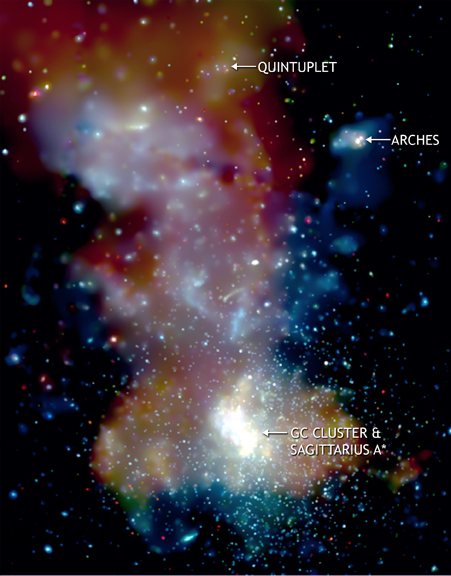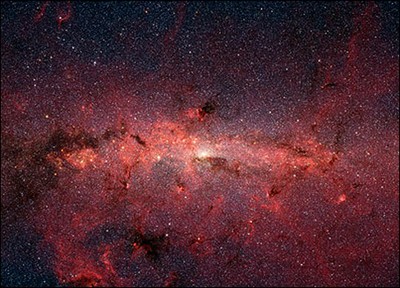[/caption]
The center of the Milky Way is a pretty happenin’ place. As with most other galaxies, there is a supermassive black hole there. Ours is named Sagittarius A* (pronounced “Sagittarius A-star”, abbreviated as Sgr A*). Not only does Sgr A* try to eat anything that goes near it, the area around it is a good place for new stars to form.
Since a black hole has such a huge gravitational footprint, it tries to suck up anything that comes within its reach. All of this gravity can attract a huge amount of matter, which bunches up around the black hole and heats up. The bunched up matter is called an accretion disk, and because of friction the gas and dust heats up, emitting infrared light. Looking at the center of the Milky Way doesn’t reveal much in visible light, but radio, infrared, and X-ray telescopes can tell us a lot about the black hole lurking there.
The Milky Way’s center is 26,000 light-years from Earth, and Sgr A* is measured to be about 14 million miles across. This means that the black hole itself would easily fit inside the orbit of Mercury. How much mass is crammed inside this relatively small space? The lower mass limit of the black hole itself is calculated to be more than 40,000 Suns. However, the radio-emitting part of Sgr A* is a bit bigger, about the size of the Earth’s orbit around the Sun (93 million miles), and weighs much, much more – 4 billion Suns.
The black hole at the center is very active, spitting out flares of gas from stars it has eaten. If you want to know more, there is a whole book written just about our very own supermassive black hole.
Sgr A* isn’t the only thing at the heart of the Milky Way. There are massive star clusters, such as the Arches,Quintuplet, and the GC star cluster. The stars in these clusters are also very bright in the X-ray part of the spectrum, as winds blowing off their surfaces collide with gas emitted from other stars in the region. The clusters are slamming into clouds of molecular gas, creating more diffuse emissions in the X-ray spectrum. These collisions may result in a higher proportion of more massive stars than low-mass ones in the Galactic center, compared to a quieter neighborhood. Here’s a longer article about the image below.

For more information on the Milky Way, listen to Episode 99 of Astronomy Cast.
Source: NASA

